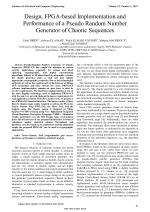| 2/2021 - 5 |
Design, FPGA-based Implementation and Performance of a Pseudo Random Number Generator of Chaotic SequencesDRIDI, F. |
| Extra paper information in |
| Click to see author's profile in |
| Download PDF |
Author keywords
chaotic, field programmable gate arrays, hardware, performance evaluation, statistical analysis
References keywords
chaotic(10), systems(9), random(8), generation(6), chaos(6), applications(6), implementation(5), design(5), circuits(5), theory(4)
Blue keywords are present in both the references section and the paper title.
About this article
Date of Publication: 2021-05-31
Volume 21, Issue 2, Year 2021, On page(s): 41 - 48
ISSN: 1582-7445, e-ISSN: 1844-7600
Digital Object Identifier: 10.4316/AECE.2021.02005
Web of Science Accession Number: 000657126200005
SCOPUS ID: 85107700679
Abstract
Pseudo-Random Number Generator of Chaotic Sequences (PRNG-CS) has caught the attention in various security applications, especially for stream and block ciphering, steganography, and digital watermarking algorithms. Indeed, in all chaos-based cryptographic systems, the chaotic generator plays a vital role and exhibits appropriate cryptographic properties. Due to the technological outbreak, as well as the rapid growth of the Internet of Things (IoT) technology and their various use cases, PRNGs-CS software implementation remains an open issue to meet its service requirements. The hardware implementation is one of the most flagship technology used to implement PRNGs-CS with the aim is to provide high-performance requirements for such application security. Therefore, in this work, we propose a new PRNGs-SC-based architecture. The latter consists of three discrete chaotic maps weakly coupled, as well as, the Piecewise Linear Chaotic Map (PWLCM), the Skew Tent, and the Logistic map. The chaotic system is designed on Xilinx Spartan-6 FPGA-board, using Very High-Speed Integrated Circuit Hardware Description Language (VHDL). Simulation results, performed over the ISE Design Suite environment, prove the effectiveness of our proposed architecture in terms of robustness against statistical attacks, throughput, and hardware cost. So, based on its architecture and the simulation results the proposed PRNG-SC can be used in cryptographic applications. |
| References | | | Cited By |
Web of Science® Times Cited: 1 [View]
View record in Web of Science® [View]
View Related Records® [View]
Updated 2 weeks, 5 days ago
SCOPUS® Times Cited: 4
View record in SCOPUS® [Free preview]
View citations in SCOPUS® [Free preview]
[1] FPGA Implementation of a Chaotic Pseudo-random Numbers Generator, Abderrahim, N. W., Benmansour, F. Z., Seddiki, O., SN Computer Science, ISSN 2661-8907, Issue 4, Volume 4, 2023.
Digital Object Identifier: 10.1007/s42979-023-01837-7 [CrossRef]
[2] A Review on Applications of Chaotic Maps in Pseudo-Random Number Generators and Encryption, Naik, Rasika B., Singh, Udayprakash, Annals of Data Science, ISSN 2198-5804, Issue 1, Volume 11, 2024.
Digital Object Identifier: 10.1007/s40745-021-00364-7 [CrossRef]
[3] Enhanced Chaotic Pseudorandom Number Generation Using Multiple Bernoulli Maps with Field Programmable Gate Array Optimizations, Palacios-Luengas, Leonardo, Medina-Ramírez, Reyna Carolina, Marcelín-Jiménez, Ricardo, Rodriguez-Colina, Enrique, Castillo-Soria, Francisco R., Vázquez-Medina, Rubén, Information, ISSN 2078-2489, Issue 11, Volume 15, 2024.
Digital Object Identifier: 10.3390/info15110667 [CrossRef]
[4] Chaotic Maps in Cryptography, Saeed, Hala, El sobky, Wageda I., Diab, Tamer O., Elsisi, M. A., 2024 International Telecommunications Conference (ITC-Egypt), ISBN 979-8-3503-5140-8, 2024.
Digital Object Identifier: 10.1109/ITC-Egypt61547.2024.10620474 [CrossRef]
Disclaimer: All information displayed above was retrieved by using remote connections to respective databases. For the best user experience, we update all data by using background processes, and use caches in order to reduce the load on the servers we retrieve the information from. As we have no control on the availability of the database servers and sometimes the Internet connectivity may be affected, we do not guarantee the information is correct or complete. For the most accurate data, please always consult the database sites directly. Some external links require authentication or an institutional subscription.
Web of Science® is a registered trademark of Clarivate Analytics, Scopus® is a registered trademark of Elsevier B.V., other product names, company names, brand names, trademarks and logos are the property of their respective owners.
Faculty of Electrical Engineering and Computer Science
Stefan cel Mare University of Suceava, Romania
All rights reserved: Advances in Electrical and Computer Engineering is a registered trademark of the Stefan cel Mare University of Suceava. No part of this publication may be reproduced, stored in a retrieval system, photocopied, recorded or archived, without the written permission from the Editor. When authors submit their papers for publication, they agree that the copyright for their article be transferred to the Faculty of Electrical Engineering and Computer Science, Stefan cel Mare University of Suceava, Romania, if and only if the articles are accepted for publication. The copyright covers the exclusive rights to reproduce and distribute the article, including reprints and translations.
Permission for other use: The copyright owner's consent does not extend to copying for general distribution, for promotion, for creating new works, or for resale. Specific written permission must be obtained from the Editor for such copying. Direct linking to files hosted on this website is strictly prohibited.
Disclaimer: Whilst every effort is made by the publishers and editorial board to see that no inaccurate or misleading data, opinions or statements appear in this journal, they wish to make it clear that all information and opinions formulated in the articles, as well as linguistic accuracy, are the sole responsibility of the author.



